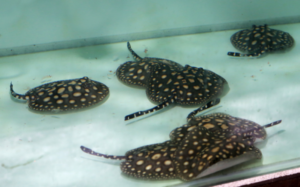They are gentle creatures in the wild. They swim away or [become] afraid when we push them or make sundot (poke them),” says Arvin Gonzales, who tends the Sharks and Rays Dry Encounter at Ocean Park. “We have 22 stingrays and 4 species: cowtail, black-blotched, Jenkins’, and leopard whipray. This particular stingray is the common cowtail seen in Bohol and Palawan.”

An animal lover, the former videographer owns 37 ball pythons, 2 boa constrictors, and freshwater stingrays too. “My dad loves dogs but I love reptiles and aquatic animals more. I work from 11 a.m. to 5 p.m. I start the day by cleaning the tank, checking the life support system, [particularly the] water salinity and water level of this 3-foot deep seawater pool. If the water is too filtered or clean, [the] salinity will go down. There must be a certain pH level to maintain,” the chemistry graduate from U.P. says.
Indicating a particularly interesting species, Arvin says, “This cowtail stingray measures around 3 feet and [is] about 7 to 8 years old. It can grow much bigger. The largest cowtail stingray on record measures 1.4 meters.”
“It’s a male and has two claspers or male organs. Don’t touch the tail, lest it…create a big splash and the visitors will get wet. And it’s not fun when you’re wet,” he adds, as he lets a toddler held by his mom touch the brown stingray, which looks like a blanket.
“We feed them…fish and squid. They also get sick. They lose their appetite, become paler, and their brown slimy texture becomes dry. The slimier, the healthier [they are],” Arvin says. “Notice the water comes out from their spiracles and the water comes in through their gills. They also sleep by burying themselves in the sand.”
According to Wikipedia, “…the flattened bodies of stingrays allow them to effectively conceal themselves in their environment. Stingrays do this by agitating the sand and hiding beneath it. Because their eyes are on top of their bodies and their mouths on the undersides, stingrays cannot see their prey; instead, they use smell and electroreceptors (ampullae of Lorenzini) similar to those of sharks. Stingrays feed primarily on molluscs, crustaceans, and occasionally on small fish. Some stingrays’ mouths contain two powerful, shell-crushing plates, while other species only have sucking mouthparts. Stingrays settle on the bottom while feeding, often leaving only their eyes and tail visible. Coral reefs are favorite feeding grounds and are usually shared with sharks during high tide.”
When asked if his future wife must be an animal lover too, Arvin laughs, “Well, my fiancée isn’t into animals, but she appreciates my snakes!”
This story appeared in Animal Scene’s August 2015 issue.




